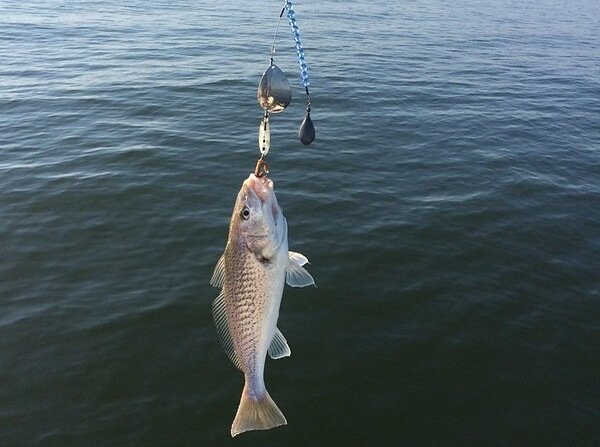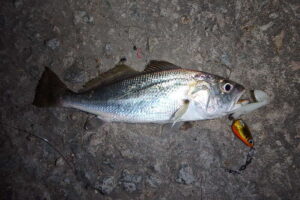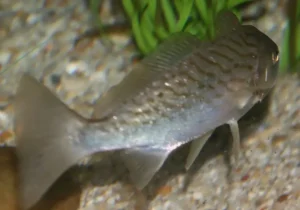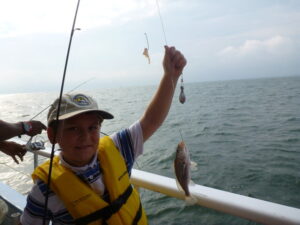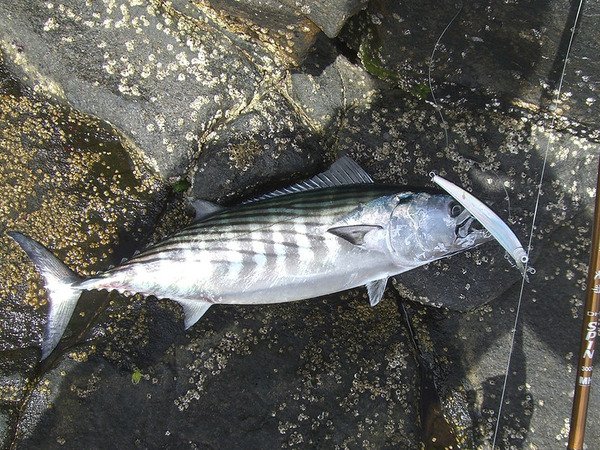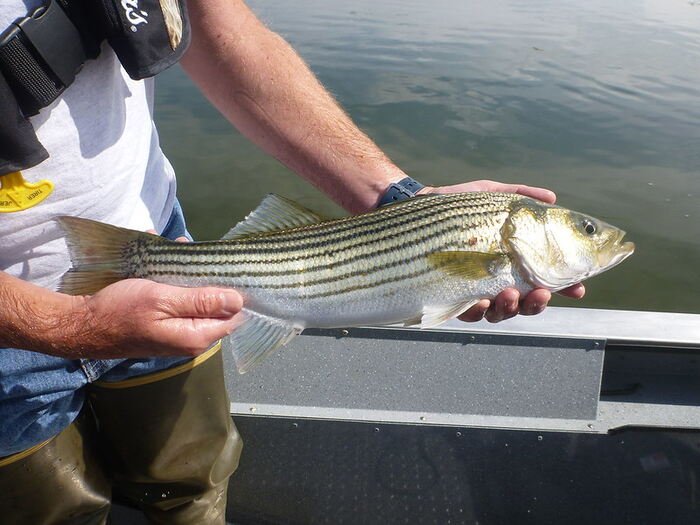I embarked on a croaker fishing adventure that I won’t soon forget. The thrill of catching these feisty bottom-dwellers is something every angler should experience. Fishing is all about timing, and I hit the sweet spot this year. Arriving at the Chesapeake Bay in late summer, I found the croaker population booming. The warm waters were teeming with activity, and it was the perfect setting for a successful fishing trip.
Equipped with medium-action rods and bottom rigs, I set out early in the morning, just as the tide was coming in. My bait of choice was bloodworms, a classic favorite for croaker. The fish were biting steadily, and within hours, I had a cooler full of good-sized croakers.
Each catch brought a satisfying pull on the line, a sign of the croaker’s characteristic fight. The experience was made even better by the serene surroundings—a calm bay, the sound of water gently lapping against the boat, and the occasional call of seabirds overhead.
What stood out this year was the size of the croakers. They were larger than I’d seen in previous years, likely due to the favorable conditions. This trip reminded me why I love fishing for croaker—it’s not just about the catch, but the entire experience.
Understanding Croaker Fishing
Fishing is a popular pastime for anglers of all skill levels. Known for their distinctive croaking sound, these fish are a favorite in coastal waters, especially along the Atlantic and Gulf coasts of the United States. In this article, we’ll dive into everything you need to know about fishing, from identifying these fish to the best techniques and gear for catching them.
What is a croaker?
Croakers are a type of saltwater fish belonging to the drum family, which also includes species like red drum and black drum. The name “croaker” comes from the unique sound they produce by vibrating their swim bladder. The most commonly targeted croaker species in the U.S. is the Atlantic croaker (Micropogonias undulatus). These fish have a silver or bronze hue with faint horizontal stripes along their sides and a downturned mouth that helps them forage on the ocean floor.
Where to Find Croaker
Croaker are typically found in shallow coastal waters, including bays, estuaries, and tidal creeks. They prefer sandy or muddy bottoms where they can root around for food, such as small crustaceans, worms, and other invertebrates. During the warmer months, they move closer to shore, making them accessible to shore and pier anglers. In the winter, they often migrate to deeper waters offshore.
Best Time to Catch Croaker
The best time to catch croaker is during the warmer months, from late spring through early fall. These fish are most active when the water temperature is between 70°F and 85°F. Early morning and late afternoon are prime times for fishing, as they tend to feed more aggressively during these cooler parts of the day. Night fishing can also be productive, especially in areas where croakers are known to congregate.
Tackle and Gear for Fishing
When it comes to tackle and gear, croaker fishing is relatively straightforward. A light to medium spinning rod and reel combo is ideal, with a 6- to 10-pound test monofilament or braided line. Croakers aren’t particularly large or strong fighters, so heavy gear isn’t necessary.
Hooks and Rigs
The best hooks for fishing are small, sharp, and strong. Size 4 to 1/0 circle hooks or J-hooks are commonly used. Since croakers often feed on the bottom, a simple bottom rig is the most effective setup. The most popular rig is a two-hook bottom rig, which consists of a mainline with a sinker at the bottom and two dropper loops with hooks above it. This rig allows you to present bait close to the bottom, where croakers are actively feeding.
Bait Selection
Croakers are opportunistic feeders, so they’ll eat a variety of baits. Fresh or live bait is always preferred, as croakers are attracted to the scent and movement. Some of the best baits for croakers include:
- Bloodworms: One of the most effective baits for croakers, bloodworms are readily available at most bait shops and are irresistible to these fish.
- Shrimp: Fresh or frozen shrimp, either whole or cut into pieces, is another excellent choice. Peeling the shrimp can release more scent into the water, attracting croaker from a distance.
- Squid: Strips of squid are durable and stay on the hook well, making them a good option for targeting croakers in areas with a strong current.
- Clams and Mussels: These baits are natural food sources for croaker and can be very effective when fishing in areas where these shellfish are abundant.
- Cut Bait: Pieces of cut bait, such as mullet or menhaden, can also work well, especially when targeting larger croakers.
Fishing Techniques
Fishing can be as simple or as involved as you want it to be. Here are some popular techniques:
Bottom Fishing
Bottom fishing is the most popular technique for catching croaker. Cast your baited rig out into the water, let it sink to the bottom, and wait for a bite. Croaker typically bite with a series of rapid taps or pulls, so keep your line tight and be ready to set the hook.
Drift Fishing
Drift fishing is another effective technique, especially when fishing from a boat. This involves allowing your boat to drift with the current while your baited rig is on or near the bottom. This method covers more ground and can help you locate schools of croaker.
Pier and Surf Fishing
Pier and surf fishing are popular ways to target croaker. From a pier, cast your line out beyond the breakers or near the pilings, where croakers often congregate. In surf fishing, look for deeper troughs or holes in the surf zone where croaker might be feeding. The key is to keep your bait on or near the bottom.
Catch and Release
While croakers are often kept for their delicious, mild-flavored meat, it’s important to practice catch and release if you’re not planning to eat your catch. Use a dehooking tool to minimize harm to the fish, and handle them as little as possible to protect their slime coat. Return them to the water quickly to ensure their survival.
Cooking and Eating Croaker
Croakers are prized for their white, flaky meat, which has a mild flavor that’s perfect for a variety of dishes. They can be grilled, fried, baked, or broiled, making them a versatile choice for the table. One of the simplest and most popular ways to prepare croaker is to fry them whole after scaling and gutting. Season the fish with salt, pepper, and a bit of lemon juice, then dredge in flour or cornmeal before frying in hot oil until golden brown.
Regulations and Conservation
Before heading out to fish for croaker, it’s essential to check the local fishing regulations in your area. Bag limits, size limits, and seasons can vary by state and region. Following these regulations helps ensure that croaker populations remain healthy and sustainable for future generations of anglers.
Tips for Successful Fishing
Here are some additional tips to increase your chances of success when fishing for croaker:
- Keep it Fresh: Fresh bait is key to attracting croaker. Make sure your bait is as fresh as possible, and don’t be afraid to switch it out if it’s not getting bites.
- Use a Light Touch: Croakers have relatively soft mouths, so it’s important not to set the hook too hard. A gentle lift of the rod tip is usually enough to hook them.
- Remain Mobile: Don’t be scared to move around if you’re not getting bit.
- Be Patient: Fishing can sometimes require patience, especially if they’re not actively feeding. Keep your bait in the water and be ready when the bite turns on.
The Joy of Croaker Fishing
Fishing is a fun and rewarding experience for anglers of all ages. Whether you’re fishing from shore, a pier, or a boat, the thrill of feeling that telltale croaker bite never gets old. Plus, with their mild, delicious meat, croaker make for an excellent meal at the end of a day on the water.
Final Thoughts
Whether you’re a seasoned angler or just starting, fishing offers an enjoyable way to spend time outdoors. With the right gear, bait, and techniques, you’ll be well on your way to a successful day of fishing. Remember to respect local regulations, practice good conservation, and most importantly, enjoy the process. Happy fishing!
